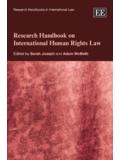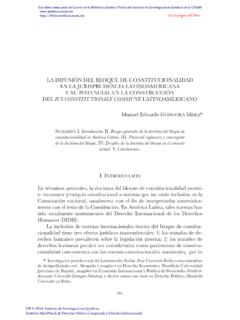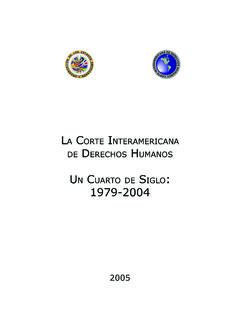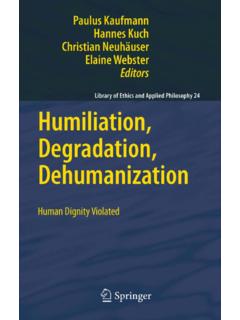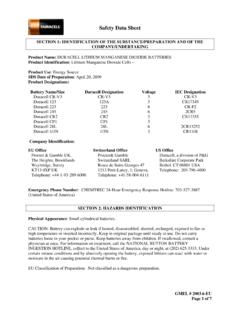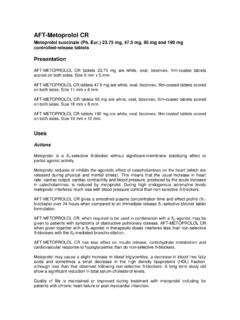Transcription of Inter-American Court of Human Rights Case of …
1 Inter-American Court of Human Rights Case of Vel squez - rodr guez v. Honduras Judgment of July 29, 1988 (Merits) In the Vel squez rodr guez case, The Inter-American Court of Human Rights , composed of the following judges: Rafael Nieto-Navia, President H ctor Gros Espiell, Vice President Rodolfo E. Piza E., Judge Thomas Buergenthal, Judge Pedro Nikken, Judge H ctor Fix-Zamudio, Judge Rigoberto Espinal Ir as, Judge ad hoc Also present: Charles Moyer, Secretary Manuel Ventura, Deputy Secretary delivers the following judgment pursuant to Article 44 (1) of its Rules of Procedure (hereinafter "the Rules of Procedure") in the instant case submitted by the Inter-American Commission on Human Rights against the State of Honduras.
2 1. The Inter-American Commission on Human Rights (hereinafter "the Commission") submitted the instant case to the Inter-American Court of Human Rights (hereinafter "the Court ") on April 24, 1986. It originated in a petition (No. 7920) against the State of Honduras (hereinafter "Honduras" or "the Government"), which the Secretariat of the Commission received on October 7, 1981. 2. In submitting the case, the Commission invoked Articles 50 and 51 of the American Convention on Human Rights (hereinafter "the Convention" or "the American Convention") and requested that the Court determine whether the State in question had violated Articles 4 (Right to Life), 5 (Right to Humane Treatment) and 7 (Right to Personal Liberty) of the Convention in the case of Angel Manfredo Vel squez rodr guez (also known as Manfredo Vel squez ).
3 In addition, the Commission asked the Court to rule that "the consequences of the situation that constituted the breach of such right or freedom be remedied and that fair compensation be paid to the injured party or parties." 3. According to the petition filed with the Commission, and the supplementary information received subsequently, Manfredo Vel squez , a student at the National Autonomous University of Honduras, "was violently detained without a warrant for his arrest by members of the National Office of Investigations (DNI) and G-2 of the Armed Forces of Honduras." The detention took 2 place in Tegucigalpa on the afternoon of September 12, 1981. According to the petitioners, several eyewitnesses reported that Manfredo Vel squez and others were detained and taken to the cells of Public Security Forces Station No.
4 2 located in the Barrio El Manch n of Tegucigalpa, where he was "accused of alleged political crimes and subjected to harsh interrogation and cruel torture." The petition added that on September 17, 1981, Manfredo Vel squez was moved to the First Infantry Battalion, where the interrogation continued, but that he police and security forces denied that he had been detained. 4. After transmitting the relevant parts of the petition to the Government, the Commission, on various occasions, requested information on the matter. Since the Commission received no reply, it applied Article 42 (formerly 39) of its Regulations and presumed "as true the allegations contained in the communication of October 7, 1981 concerning the detention and possible disappearance of Angel Manfredo Vel squez rodr guez in the Republic of Honduras" and pointed out to the Government "that such acts are most serious violations of the right to life (Art.)
5 4) and the right to personal liberty (Art. 7) of the American Convention" (Resolution 30/83 of October 4, 1983). 5. On November 18, 1983, the Government requested reconsideration of Resolution 30/83 on the grounds that domestic remedies had not been exhausted, that the National Office of Investigations had no knowledge of the whereabouts of Manfredo Vel squez , that the Government was making every effort to find him, and that there were rumors that Manfredo Vel squez was "with Salvadoran guerrilla groups." 6. On May 30, 1984, the Commission informed the Government that it had decided, "in light of the information submitted by the Honorable Government, to reconsider Resolution 30/83 and to continue its study of the case." The Commission also asked the Government to provide information on the exhaustion of domestic legal remedies.
6 7. On January 29, 1985, the Commission repeated its request of May 30, 1984 and notified the Government that it would render a final decision on the case at its meeting in March 1985. On March 1 of that year, the Government asked for a postponement of the final decision and reported that it had set up an Investigatory Commission to study the matter. The Commission agreed to the Government's request on March 11, granting it thirty days in which to present the information requested. 8. On October 17, 1985, the Government presented to the Commission the Report of the Investigatory Commission. 9. On April 7, 1986, the Government provided information about the outcome of the proceeding brought in the First Criminal Court against those persons supposedly responsible for the disappearance of Manfredo Vel squez and others.
7 That Court dismissed the complaints "except as they applied to General Gustavo Alvarez Mart nez, because he had left the country and had not given testimony." This decision was later affirmed by the First Court of Appeals. 10. By Resolution 22/86 of April 18, 1986, the Commission deemed the new information presented by the Government insufficient to warrant reconsideration of Resolution 30/83 and found, to the contrary, that "all evidence shows that Angel Manfredo Vel squez rodr guez is still missing and that the Government of Honduras .. has not offered convincing proof that would allow the Commission to determine that the allegations are not true." In that same Resolution, the Commission confirmed Resolution 30/83 and referred the matter to the Court .
8 I 3 11. The Court has jurisdiction to hear the instant case. Honduras ratified the Convention on September 8, 1977 and recognized the contentious jurisdiction of the Court , as set out in Article 62 of the Convention, on September 9, 1981. The case was submitted to the Court by the Commission pursuant to Article 61 of the Convention and Article 50 (1) and 50 (2) of the Regulations of the Commission. II 12. The instant case was submitted to the Court on April 24, 1986. On May 13, 1986, the Secretariat of the Court transmitted the application to the Government, pursuant to Article 26 (1) of the Rules of Procedure. 13. On July 23, 1986, Judge Jorge R. Hern ndez Alcerro informed the President of the Court (hereinafter "the President") that, pursuant to Article 19 (2) of the Statute of the Court (hereinafter "the Statute"), he had "decided to recuse (him)self from hearing the three cases that.
9 Were submitted to the Inter-American Court ." The President accepted the disqualification and, by note of that same date, informed the Government of its right to appoint a judge ad hoc under Article 10 (3) of the Statute. The Government named Rigoberto Espinal Ir as to that position by note of August 21, 1986. 14. In a note of July 23, 1986, the President confirmed a preliminary agreement that the Government present its submissions by the end of August 1986. On August 21, 1986, the Government requested the extension of this deadline to November 1986. 15. By his Order of August 29, 1986, having heard the views of the parties, the President set October 31, 1986 as the deadline for the Government's presentation of its submissions.
10 The President also fixed the deadlines of January 15, 1987 for the filing of the Commission's submissions and March 1, 1987 for the Government's response. 16. In its submissions of October 31, 1986, the Government objected to the admissibility of the application filed by the Commission. 17. On December 11, 1986, the President granted the Commission's request for an extension of the deadline for the presentation of its submissions to March 20, 1987 and extended the deadline for the Government's response to May 25, 1987. 18. In his Order of January 30, 1987, the President made clear that the application which gave rise to the instant proceeding should be deemed to be the Memorial provided for in Article 30(3) of the Rules of Procedure.
